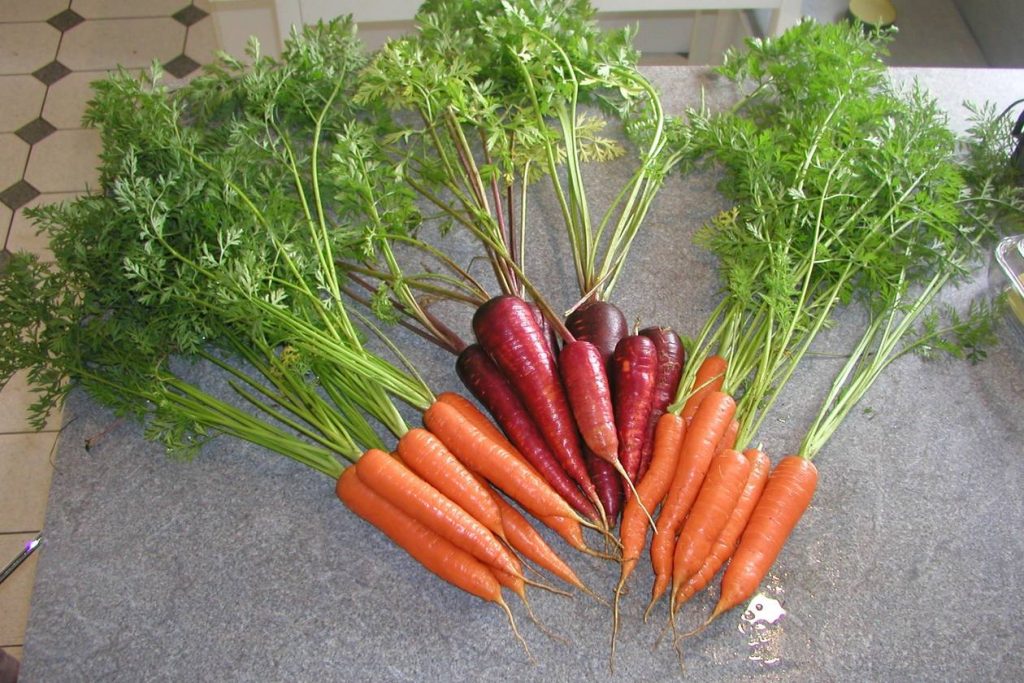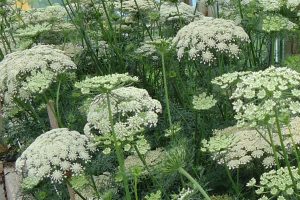Carrots are biennial which means that they spend the first year of their life developing the tuber, the carrot that we eat. If, instead of harvesting them, you leave them in the ground in the second year the plant will use the energy stored in the root to throw up a stalk and flower heads that will produce seed.
 General Carrot Seed Saving
General Carrot Seed Saving
If you live in an area with mild winters, just leave the carrots in the ground as winter arrives and the fern dies off. Then give them a good mulch with leafmould or compost to protect them until spring.
In cold areas, dig up your carrots and select the best roots. Twist off the foliage and store in dry sand or peat just as you would store crops for eating.
In spring replant the carrots into the ground and just like the ones left in the ground in milder areas, they will begin to re-grow and throw up large flat flower heads which can reach a metre high.
Carrots, being insect pollinated, can cross-pollinate with other carrots in flower in the neighbourhood within 500 metres and with the wild carrot, Queen Anne’s Lace. Since so few gardeners save their own carrot seed nowadays, in practice this is not a major problem.
If you do get some crosses with wild carrots you can just discard those roots when you save seed in subsequent years.
Genetic Drift in Home Seed Saved Carrots
If you save seed from just a few carrots you will probably suffer something called genetic drift and the quality will deteriorate markedly over the years. Ideally you should have a pool of around 40 to 50 plants to save seed from.
Harvesting & Collecting Carrot Seed
To harvest your carrot seeds is fairly easy. Once the flower heads or umbels as this type of flower head are properly called start to turn brown and dry, cut them off the stalk. Bring them indoors or undercover to dry thoroughly.
Do not use a dehydrator or oven as the heat will be too much and your saved seeds will not be viable.
Rub the dried heads between your hands and separate the seeds. You’ll notice that carrot seeds have a beard. Commercially these are removed as it makes for easier packing but I’d say leave them on as they also make for easier handling at sowing time.
Keep in a cool place in the dark and the seeds should be 70% viable (i.e. 30% of the seeds will be non-viable duds) for 3 years. By 5 years as little as 30% of the seeds will be viable and you desperately need fresh stocks!
Those growing for show tend to go to more trouble to ensure they save and enhance the characteristics they want and avoid cross-pollination. See Producing Your Own Carrot Seed in the show-growing section.
Seed Saving Articles, Information & Resources
- Freezing and Cold Storing Seeds for Long Term Storage
- Saving Your Own Seeds – General Guide to Seed Saving
- Seed Saving to Improve Biodiversity
- Seed Storage & Longevity Lifespan – How Long Seeds Will Keep For
- Seed Germination & Viability Testing
- Seed Saving: Storing Seeds: Seed Viability
- What Are F1 Plants & Seeds: How & Why of F1 Hybrids
- Seed Saving Heirloom or Heritage Seeds
- Seed Saving: Carrots | Save Your Own Carrot Seed
- Seed Saving: Peas | Save Your Own Pea Seed
- Seed Saving: Tomatoes | Save Your Own Tomato Seed




